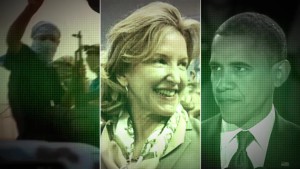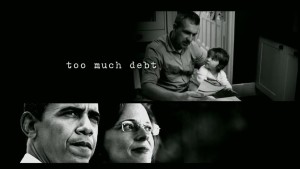ВИЗУАЛЬНЫЕ СРЕДСТВА ВОЗДЕЙСТВИЯ В АМЕРИКАНСКОЙ ПОЛИТИЧЕСКОЙ РЕКЛАМЕ
Аннотация
Metaphorical representation of facts is a rich source of creativity. When something known is applied to something new, it is easier to perceive and trust. But what is metaphor? For a long history of science, metaphor has come a long way from a means of emphatic speech to a cognitive mechanism which serves for learning and categorization of reality.
Credit for cognitive understanding of metaphor is deserved by George Lakoff and Mark Johnson, who implemented a two-space model of mapping from the source domain to the target domain and who studied metaphor not only on the linguistic level but also on the level of cognition and activity [6]. А.P. Chudinov expanded the theory of metaphor conceptual analysis by frames and slots and introduced semantic spheres serving as the source of metaphoric expansion. These spheres are: anthropomorphic metaphors, due to which the person represents the surrounding world through their own being, natural metaphors, interpreting the reality through natural phenomena, socio-morphic metaphors, simulating the world on the basis of people’s social life, and artefactual metaphors, connected with people’s creative abilities [4].
All theories mentioned above are based on the idea that metaphor is a composition of characteristics of one object applied to characteristics of another, what leads to the mixture of their features. In modern linguistics this process is called blending, or the theory of conceptual integration by G. Fauconnier and Mark Turner. Blending is a process that happens reflexively, in the depths of our conscious.
Mark Turner describes blending as a natural process forming the basis of our mind,
Blending is not something special or costly. Blending operates almost entirely below the horizon of consciousness. We usually never detect the process of blending and typically do not recognize its products as blends. Very rarely, the scientists can drag a small part of blending onstage, where we can actually see it. But the mind is not made for looking into the mind, and as a result, we see blending only infrequently, and poorly» [7, 18].
The process of blending happens automatically and is the result of the combination of different ideas into a brainchild. It exactly what happens in TV commercials. Most scholars define advertising as communication between the consumer and the advertiser, the purpose of which is not only to deliver a message, or inform about the product/service, but also to impact psychologically, to involve the customer into the process of commercial communication, to create a favourable image of the product, to arouse a desire, to persuade the customer in the necessity of the product [1]. The main aim of the advertising is to produce an impact on the prospective buyer. To achieve this aim advertisers use various tools and techniques.
The mixture of text, sound and picture causes a comprehensive impact on people’s mind. How does it happen? The first thing that matters is the object of advertising, something that needs to be promoted. It can be a thing, a person or an idea. The advertising is usually directed to the target audience, who are more likely to choose this object. V. Muzicant emphasizes that the target audience is characterized by the following factors: biological (gender, age, character, appearance), psychological (emotions, mood, will) and social (values, purposes, ability to inherit social experience of the previous generation) [2]. Thus, the object and the target audience are two essential components serving as input spaces for the future ad.
The image of the object is visualized with the help of a picture. Nowadays a simple picture does not impress any more, and admen invent different tricks to make the image catchy. The whole clip consists of a series of shots. The better the shot, the more memorable the clip is. Another way to achieve effects is framing. The object is usually positioned in such a way as to be seen more impressively. It can be framed close up, far away, or from different angles. The variation of lighting conveys some meaning as well. The use of dark triggers negative emotions and fear, the use of bright is associated with joy and happiness. The choice of colour determines the general atmosphere of the ad. The setting varies in terms of the object of advertising. It can picture a traditional scene (family, house, school, job), adopt something unusual (films, cartoons, comics) or combine several locations. Therefore, the picture together with its main elements (shot, framing, lighting and setting) forms the third input space.
Text can be presented in oral and written form. The content of the text can be different. The pronounced text introduces the object, describes its characteristics and persuades to choose it. The written text emphasizes the most relevant features of the object and implements the slogan.
The audible component produces conscious and subconscious effects. The song is usually perceived consciously as the audience try to catch the sense of the words, while simple music is usually played on the background of words and written text and is therefore perceived subconsciously. Subconscious meaning is also carried by sound effects, for example loud sound always draws attention while repeated pounding causes irritation.
All the recited components are interconnected by one common topic that links directly to the object of advertising. All together these components form an ad. They are part of one process which is unique and complex.
In the XX and XXI century advertising has been transformed from the economic phenomenon into an integral part of mass culture, thus not only carrying information about promoted things or ideas, but also conveying social, political and cultural attitudes. In most cases such effect is created by a mixture of various tools: frequently repeated words and slogans, adopted scenarios (everyday situations, shots from films, cartoons and so on), popular music overlaid on advertising texts, and the employment of famous people and images. In other words, any advertising clip is a megablend formed by several spaces such as picture, text, sound, target audience and the object of advertising itself.
The role of advertising nowadays can hardly be overestimated. It influences the choice of goods we buy and ways we think. Therefore, it is not surprising that political life is often touched by advertising. Politicians make resort to commercials for achieving various purposes: to make a name, to reveal their ideas, to blacken their opponents’ reputation. It is especially true about American political advertising. To sound more persuasive American politicians work hard on their promotion and, as a rule, use the most popular and highly sought media – television or the Internet. As a result TV and Internet advertising is turning into art. Nonstandard approaches are implemented on all levels of ads.
To attract the customer, 30-second advertising clips are elaborated so scrupulously that they can impact the viewer on all levels (mental spaces). In general, there are several types of psychological impact: cognitive (communication of information), emotive (inducement to feelings and emotions), suggestive (hypnosis), conative (behavioural influence) [3, P. 100-103].
The most powerful tool in advertising clips is picture. This mental space conveys more information than text. Let us consider some main elements of the mental space of picture and how they influence the viewer. Picture in advertising is not just a simple amateur shot. To appeal to people’s feelings admen use extraordinary combinations of camera shots, framing, lighting and setting.
Commercials shots rarely picture the same view for a long time, because it bores the audience. Shots change quickly, sometimes in every 2-3 seconds to hold the attention. But not only the speed makes sense, the types of shots have an impact too. Positive image of the candidate can be drawn with the help of shots that show him or her in front of the American flag, the map of the country or the state, and different national symbols (like Capitol). In this case, the image of the candidate is blended with the image of the country or the state.
Stand Mark Warner ‘Mixed up’
Positive feelings are also achieved with the shots of ordinary people supporting the politician. As a rule, these are quickly changing images either showing people alone or with the candidate. Such shots blend the image of the politician with ordinary people, carrying the idea of the representative of masses.
Dubious feelings are aroused by the shots with the ruling president. Such shots can be used either in favour of the candidate (if the current policy satisfies the people) or against them (if the current policy dissatisfies them). Sometimes shots depicting the president and the candidate are intended to blacken the latter. Such tendency got spread in the electorate campaign of 2014 in negative advertising. For example, in the advertising clip Cocktails, the image of the Senator from the Democratic Party Kay Hagan is juxtaposed with Barack Obama and ISIS soldiers as a symbol of inaction of both politicians in the face of a threat. Thus, Hagan’s political views are compared to those of the ruling president. Blending of both persons’ images on the unconscious level marks the similarities of their policies causing negative reaction.
Cocktails
The shots with the candidate in the news or newspapers tend to carry negative impressions caused by their ill fame. With the help of these shots the candidates’ past merges with his current electoral campaign. In this case, there is a close connection between picture and text. Close interaction of several mental spaces (object, picture and text) stipulates strong feelings.
AFP holds Landrieu accountable on Obamacare
Shots that are used most frequently portray the candidate themselves. But they can vary in framing. Framing presupposes the positioning of people or objects under a certain angle to convey necessary meanings. In political advertising if the candidate is framed close up, they are associated as equal to you, as they are talking to you face-to-face. This is usually the most common technique. Another way to introduce the candidate is to zoom in the image from the distance. Thus, it is possible to receive the whole view of the person. The most infrequent technique is to frame the candidate from a low angle. Usually it is used in negative advertising that discredits the opponent, because such perspective makes the person look superior.
Close up From a low angle
Elise Stefanik ‘Fresh ideas’ American Crossroads 'Spelling bee'
Zoom in
Nice guy
Lighting is another powerful tool used to impose the meaning. The effect of lighting is made on contrast. The positive advertising promoting the candidate themselves is bright and colorful. The negative advertising is dark, what makes the opponent look threatening or unpleasant. Sometimes advertising combines bright and dark colours for the obvious purpose, like in the ad Trust. David Perdue talking about his opponents uses black and white images but appears in contrast to them in colour display.
Trust
The last component of the picture is settings. Without a doubt, settings can be different, but the analysis of political advertising shows that there are some common scenes for shooting. The choice of the setting depends on the electoral platform of the candidate, their origin and the target audience. The setting influences the image of the candidate. The schemes showing blending of politicians’ images and settings can be shown in the following way:
a politician + family = an ordinary person → supports interests of ordinary people
a politician + factory = a factory worker → supports interests of workers
a politician + farm = a farmer → supports interests of farmers
a politician + a state office = an experienced politician → supports interests of the whole state
Of course, the person may not be as such, but it makes sense for viewers. The same can be said about some unusual settings. Highly metaphoric in its context is a set of ads called Spelling bee portraying different senators supporting President Barack Obama. The scene of the well-known traditional competition where contestants are supposed to spell words is borrowed for political blackening. This is the visual blend that merges two ideas into one.
Taking into account the main features of picture, such as shots, framing, lighting and setting, it should be pointed out that each of them conveys certain meanings both on conscious and subconscious levels. Even if it is not obvious for the viewer at first sight, these tools can be based on the metaphorical perception of things, which modern cognitive linguistics calls blends.
Political advertising is a powerful tool capable of producing psychological impact on the person by blending different concepts. The role of blending in it is hard to overestimate. The more familiar ideas are blended, the easier it is for the viewer to build the image of the candidate in their mind.
Список литературы
Гольдман И. А. Практика рекламы / И. А. Гольдман, Н. С. Добробабенко. – Новосибирск : «Интербук», 1991. – 73 с.
Музыкант В. Л. Реклама и PR-технологии / В. Л. Музыкант. – М. : Армада-пресс, 2003. – 577 с.
Ромат Е. В. Реклама. Краткий курс / Е. В. Ромат. – СПб.: Питер, 2009. – 208 с.
Чудинов А. П. Метафорическая мозаика в современной политической коммуникации / А. П. Чудинов. – Екатеринбург : Урал. гос. пед. ун-т, 2003. – 248 с.
Fauconnier G. Mappings in Thought and Language / G. Fauconnier. – USA : Cambridge University Press, 1999. – 205 p.
Lakoff G. Conceptual Metaphor. The Contemporary Theory of Metaphor / G. Lakoff // Cognitive Linguistics : Basic Readings / Ed. by D. Geeraerts. – Walter de Gruyter GmbH & Co. KG, 2006. – P. 185-238.
Turner M. The Origin of Ideas / M. Turner. – New York : Oxford University Press, 2014. – 300 p.




![AFP holds Landrieu accountable on ObamaCare[17-53-13]](/media/images/articles/AFP-holds-Landrieu-accountable-on-ObamaCare17-53-13-300x169.jpg)

![American Crossroads- 'Spelling Bee' AR[21-07-36]](/media/images/articles/American-Crossroads-Spelling-Bee-AR21-07-36-300x169.jpg)

![Nice Guy[18-45-23]](/media/images/articles/Nice-Guy18-45-23-300x169.jpg)

![Trust[18-02-08]](/media/images/articles/Trust18-02-08-300x169.jpg)